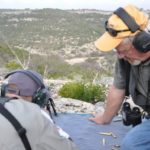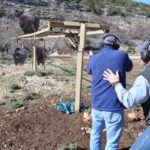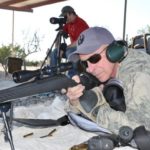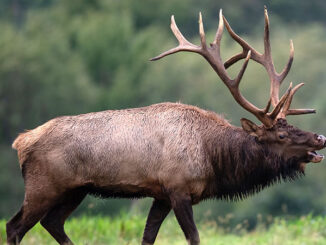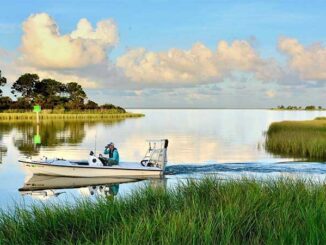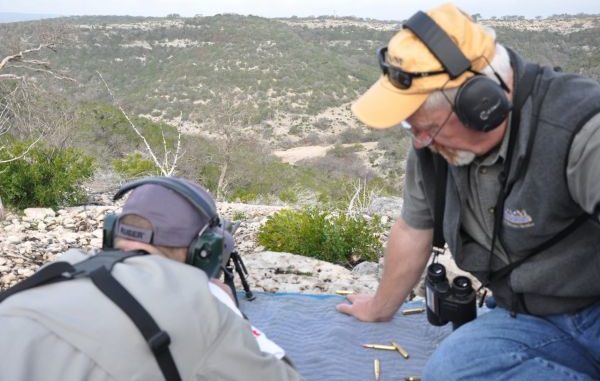
Learning the art of the rifle — and taking impossibly long shots — is a matter of expert training and a lot of shooting.
The recoil of the 168 grain Hornady Match A-Max .30-06 rammed the rifle stock backwards, pushing it straight into my shoulder—in line with the prone position I had taken in the gravel shooting pit of the rifle range.
“Riding the Bull” as Tim Fallon called it, I rocked back down onto the bipod and my rear support, a backpack, my cheek welded securely to the cheekpiece we had attached to our rifle stocks.
If we were perfectly welded to the stocks of the .30-06 Ruger American Rifles, we would be able to see the reaction of the target to the bullet strike — in other words, going up with the recoil and returning to the shooting position while never losing sight of the target — some people call it “follow-through.” Tim, ever colorful and an excellent instructor, makes it stick in your mind with defining metaphors like “Riding the Bull.”
To my satisfaction, I saw the 12-inch steel gong over 500 yards away swing violently. A second after the muzzle blast died, I heard the distinct ringing “bong” of the heavy steel plate being struck by the bullet.
We, gun writers all, had been brought into this rugged
escarpment hill country some 80 miles northwest of
San Antonio, Texas to the FTW Ranch, a 12,000-acre exotic game ranch that offers trophy hunting for whitetail deer, and Asian and African plains and mountain game.
The ranch is home to huge whitetails and wild introduced species, many of which can no longer be hunted in their native lands.
Tim Fallon, the owner of this rugged, rocky landscape, saw a need for a shooting school for hunters and long-range rifle shooters in law enforcement and the military, and founded SAAM — Sportsman’s All-Weather, All-Terrain Marksmanship.
SAAM focuses on hunter training for mountainous and plains game, and offers safari training which focuses on dangerous game hunts. The schooling has gained such a reputation that military and law enforcement special ops are using the facilities to hone their skills at long-range shooting.
Ruger Firearms had brought us to this game ranch and training facility to shoot and experience their Ruger American Rifle — the innovative bolt-action hunting rifle that incorporates numerous manufacturing designs to reduce cost, and enhance accuracy.
The result was far more than a media “shoot” to try out a new gun: Tim Fallon and his lead instructor, Doug “Dog” Prichard, put us and our rifles through a three-day version that incorporated aspects of SAAM 1, SAAM 2 and their Safari Course.
Arriving at the ranch on Sunday evening, we were treated to the first of a series of meals that proved to be sumptuous and delicious — every meal, period. This is ranch food. Ban any thought of ever going hungry during the training.
Starting Monday morning, Fallon gave us a schedule we would follow for the next several days. The 12 writers were split into two groups, and each would be taught by either Fallon or Prichard, a 26-year Navy Warrant Officer that included 25 years as a SEAL sniper instructor.
Fallon set us up on a long, sloping hill shooting down ranges beginning at 100 yards, and then extending out past 500 yards in 50 yard increments.
“Whatever was your maximum comfortable range,” he told us, “you will be shooting far past that point before this course is over.”
The Ruger American Rifles were outfitted with Harris Bi-Pods, Zeiss Conquest 3 X 9 scopes, and special Ruger strap-on cheek pads that new rifle owners can receive free of charge once they register their American Rifles with Ruger for warranty purposes.
The rifle package includes Weaver scope mounts, and the scopes were held with these mounts — an extremely strong system that proved itself when the jeep took an unscheduled violent jerk and the rifle fell from the upright rest in one of the jeeps, striking the top of the dash. A later check found the scope to be out only 1.5 inches high and 1 inch to the right at 100 yards.
That first morning, we shot the rifles from a prone position beginning at 100 yards. The guns were sighted in dead point of aim at 100 yards. The Zeiss scopes had small target turrets graduated in ¼-inch increments, meaning four clicks on the turret moved the bullet impact 1-inch at 100 yards.
Once the “baseline zero” was established for both windage and elevation, we started shooting the rifles farther and farther out, checking the elevation adjustments against the known ranges.
That evening, Fallon retired to his office and used a ballistic program considering the ballistic coefficient, sectional density, and velocity of the bullet to determine how many minutes-of-angle (4 clicks per inch) were required for our rifle/scope/bullet combination for increasing lengths of range.
The next morning, he presented each of us with our own “DOPE” or range cards for our rifles. These cards would be present in our pockets or inside the cheek pads from that day forward, and would be referred to constantly in shooting for distance.
Doug later told us the definition he had always heard for “DOPE” is “Data on Previous Engagements.” Like me, now you know ….
My personal card carried notations on elevation settings from 100 yards (baseline zero) to 700 yards — 20.75 minutes of angle to hold dead center on a 12-inch round gong and ring it at 700 yards with these .30-06 rifles.
Before this class would be over, we would all shoot these incredibly accurate rifles at those ranges, be able to estimate wind drift and angle, and ring gongs consistently.
Along with the rifle/scope/bipod/cheekpieces, we were issued PAST pads — this is a shooter’s accessory, a strap-on shoulder pad that in spite of its thin appearance dissipates the recoil from these light (6 1/4-pound) rifles and kept us all from having severely bruised shoulders after firing some 240 rounds over several days.
We were issued Ruger backpacks to carry our range cards and gear. Knowing we would be visiting different ranges across the ranch, I had brought my own personal Bushnell Compact 800 rangefinder and Valdada 10×42 binoculars.
The entire premise of taking these courses is conservation and hunter ethics. Many people who come to the ranch are going on expensive hunts in far-off places. They need to know how their rifle shoots to take advantage of a shot on trophy game when it presents itself.
As the instructors at SAAM pointed out, it is each hunter’s responsibility to take a shot only when he is certain of his ability to anchor the animal with a killing shot, not wounding or causing suffering and lingering death.
The SAAM courses ensure each hunter knows his distance and limitations. Testimonials cover their walls and fill their brochures with incredible shots made by former students. A common theme of these is the student would never have attempted such a shot without the training he (or she) received at SAAM.
In addition to shooting at distance, the courses cover judging angle up or down, and its effects on bullet drop and “doping” wind.
While shooting in a friendly 100-point match at ranges out to 535 yards with 20 targets, my “spotter” was Fredo, one of the Hispanic employees of the school. Fredo and I became a team, much like a sniper/spotter team.
The range would be called, the target identified. I would call out to Fredo, “Shooter ready!”
“Hokay, Meester Gordin… range ees 525 yards. Yellow targeet. Weend is stayday from leffft. Geeve me won gong leffft,” Fredo would advise.
What Fredo was telling me was to make sure I had set my scope elevation to 525 yards off my DOPE card, and hold the width of the plate to the left of its edge.
When I pulled the trigger and the gong sounded, Fredo would squeal with delight, “Goud Shot! Goud Shot!” and reach down from his stool behind his Zeiss spotting scope to clap me on the shoulder.
All of these instructors were past masters at reading the wind — which is more art than science. Looking downrange, they would note the effects of the wind at the target. Was it kicking up dust? Were leaves moving on the trees in the vicinity? Was the grass moving? What was wind doing to the “mirage” or visible heat waves rising in the scope’s view?
It was exhilarating to hold dead on a target at over 500 yards, have your spotter dope the wind and tell you to hold 1 1/2 plates to the left (18 inches), the vertical crosshairs completely off the plate, hold your breath while dragging the butt of the rifle solidly into your recoil pad, see the gong bounce violently and a split second later hear the ringing noise.
This was rifle country and a rifleman’s school, and I was in absolute heaven. I missed three of 20 shots, scored an 86 out of 100, and won my group.
A huge laugh was gained when I noticed I had shot practically the entire match on 3 power. That’s one of those moments when you wish you had kept your mouth shut.
Tim Fallon manages to cram an amazing amount of information on your 4-inch wide and 2 1/2-inch tall DOPE card. While the front of the card gives you MOA corrections, the back gives you formulas for figuring wind correction according to wind speed, and instructions on how to compensate for the width of your crosshairs and use the thick portions of Duplex reticles to help you aim.
If it all sounds complicated, it can be. The first morning, with Fallon and Prichard describing everything and how we would be using the features of the scopes to hit at extreme ranges, I thought, “I will never remember all this. It’s impossible!”
By the third morning, it was second nature to hear the range called, dial the turret, estimate the wind drift and hit the target consistently out to 500 yards.
And 400 yards? My old, outer limit for taking a shot? Well, it had become a chip shot.
Hunting can be expensive — especially exotic hunts that entail long travel, hard work and the possibility of getting only one shot at that record trophy you have been dreaming of collecting most of your life.
SAAM training is simple hunt insurance, a reasonable investment to ensure that hunt of a lifetime succeeds in every category, including telling your guide, “I got ’im,” when he positions you with a near impossible lengthy shot, and you watch your trophy fall DRT. “Dead. Right there.”
The exhilaration of taking game at what is called “bragging distance” is icing on what will be remembered as the hunt of a lifetime — and you can thank Fallon, Prichard and the crew at FTW Ranch for making you the skilled marksman the guides tell future clients about.
(For complete information on S.A.A.M. training, the Safari Course and the different length schools, go to www.ftwoutfitters.com. Group discounts are available.)
